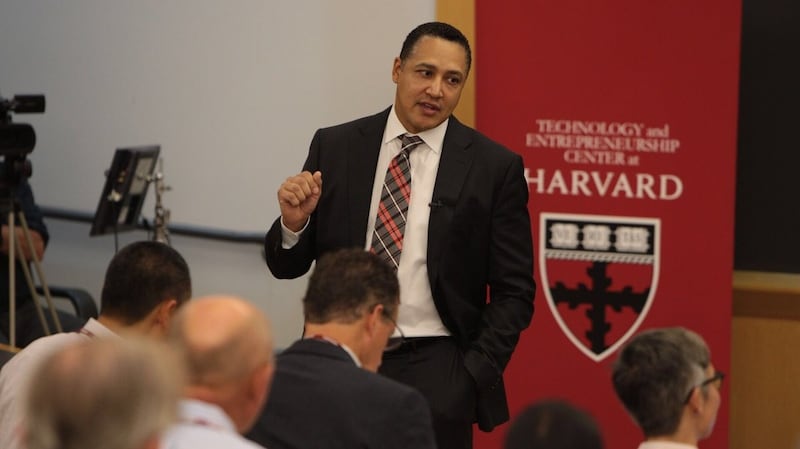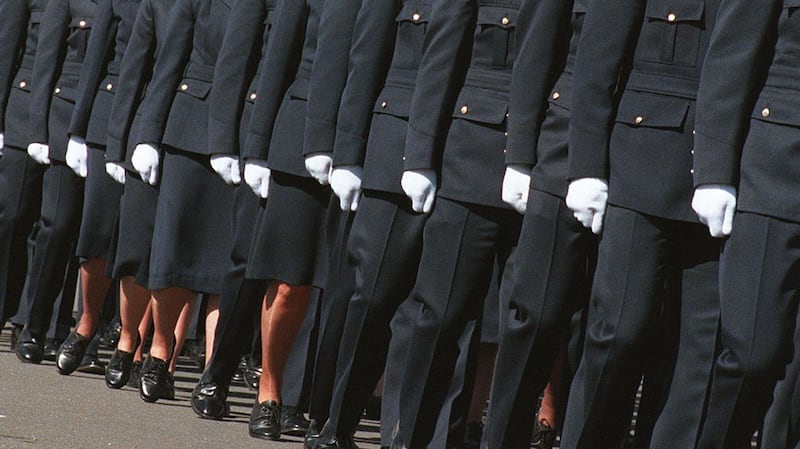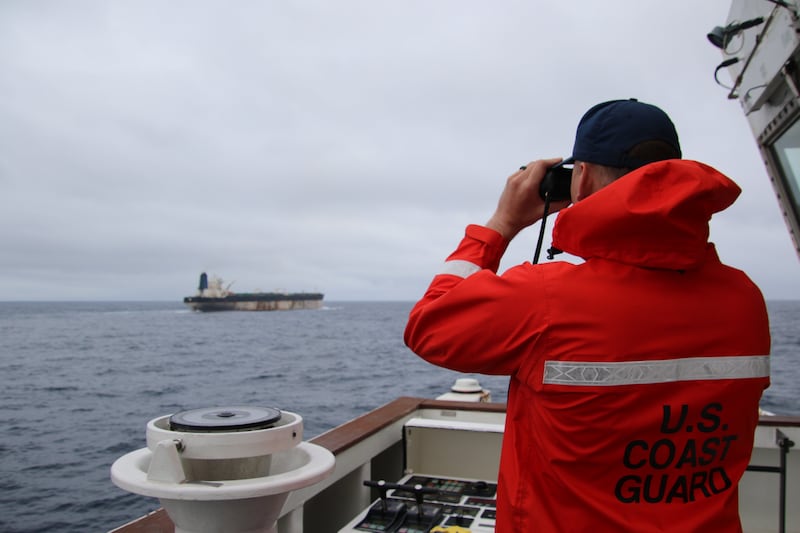In 2008, police in Cambridge took the curious step of reintroducing whistles for its officers. An antiquity of policing, these pre-1970s fixtures were used to call for back-up or to alert the attention of a passerby.
Their limited resurrection in the UK, aimed at tackling unruly cyclists, marked an unlikely throwback to old ways but it was, if anything, an exception that proved a rule. In modern policing, rapid evolutions in technology throw up myriad opportunities for investment, and important debates. Ireland is about to enter this realm of change.

Dr Antonio Oftelie, Harvard academic and expert in police technology, takes a moment to consider questions on the future shape of Irish policing before giving an answer. He explains his tendency for hybrid responses – part academic, part politician. There are so many possibilities for how An Garda Síochána might invest in its transition to a new century and Oftelie is the man with the answers. He just cannot give them away yet.
Next September, the Commission on the Future of Policing, of which he is a member, will deliver its report after about a year-and-a-half of analysis. It is a fundamental examination of all aspects of the service and follows a persistent tide of controversy within the organisation.
Technology will form an important strand of its transformation and, offered a hypothetical “blank cheque”, Oftelie has a good idea of what shape it ought to take.
Ideal capability
“Local guards have to have mobile devices. They have to have vehicles that have great remote coverage, great mobility. They have to be able to interact with systems in real time,” he says, rattling off a complete description of ideal force capability.
“We have to have open data sets for citizens so they can actually look at crime trends in their particular area. We have to have local community engagement around that data, and transparency to say: how do we create new types of solutions around crime and equity and prosperity?”
The blurring of politician and academic are immediately obvious. Oftelie interchanges seamlessly between the need to embrace technology and the debate around its use, the importance of civil liberties and how a new world of possibilities in police data should benefit both the force and its citizens.
“It’s going to take a long-term investment and staged over a number of years. The commission report will weigh that out and will probably give a horizon of time,” he says.

In reality, and in technology terms, Ireland is a long way behind in police investment. Oftelie is a fan of the word “leapfrog” – he repeats it several times. Investment will allow us to catch up but there is chance, he says, of getting ahead of other countries and setting a standard.
“We are starting at a relatively lower base so we can look to the future and say, what does a policing organisation look like in the future technologically?
“Right now in Ireland most of the guards do not have mobile capability, digital capability. They are lucky if they have a mobile phone. Most of them do not even have email that they can use with constituents and the public.”
Urgent
Oftelie says the need for investment in Ireland is now urgent. As a country we are one or two generations behind in technological terms. It is the equivalent of using whistles instead of radios in the 1980s.
“For example, virtually every modern police organisation in the world has a computer-aided dispatch [CAD], one of the most basic things you can have,” he says, and it is an example he comes back to.
“Even something like a basic CAD system, nationwide, needs to be deployed. And that’s just to bring An Garda Síochána up to the level of any policing organisation in the world right now.”
There are, of course, problems with the outdated Pulse system too – used to record Garda data. A decision must be made on whether new layers of technology are added to the existing system to improve its functions, or simply to scrap it entirely and start fresh. Both options will be expensive.
“There are many organisations around the world that have to face this decision – to get to the future do we build on top of the legacy system or do we completely rip it out and start from scratch?” he says.
“And that decision needs to be made within An Garda Síochána on where they go on that. Pulse can be quite cumbersome. Local guards generally do not like to use it for the most part. It takes a lot of time to put data in and to extract data is very problematic...there has been a lot of challenges around data accuracy in the past.”
Final report
Whatever recommendations emerges in the commission’s final report, Oftelie will help steer this technological change. At Harvard he teaches how law, policy and technology can be aligned. His doctorate research focused on constitutional and administrative law, technology and society, and institutional transformation.
The general approach toward enhancing Garda technology can be divided in two: hardware and software, both offering benefits but neither free of controversy.
The use of portable smart devices has been raised in the past and Oftelie believes such a system offers clear advantages to day-to-day policing.
“Can they, for example, input information into data systems about local conditions on the ground without having to go to a station to do that?” he says, conjuring a seemingly distant but idyllic scenario.
“Can they be safer in the context of: if I’m a guard and I get called to a house, right now in most cases I don’t have much situational awareness as to what’s behind that door. So do I know if other guards have visited that house in the past week or the past month and how many times? I might know just via word of mouth. I might know if I spend 30 minutes digging into past records and looking on paper. But for a guard you have to have real-time situational awareness.”
Risks
The risks of gardaí calling to private homes is well known. Technology that could mitigate those threats are now a point of discussion around the world.
“There has been really no investment or not a lot of investment in this in An Garda Síochána over the past decade or so and so we need to do some catch-up there.”
There are other advantages to this technology. Handheld devices could be used to file reports from a scene or a squad car without having to go back to a station. This kind of investment could save money and time; it could make the service “dramatically more efficient”.
“Right now there a lot of time spent on paper-based management methods, paper-based data input methods. If you want information it is difficult to extract it from the system.”
Are there non-lethal technologies that can be brought in? Definitely we are looking at that whether it's tasers or other methods that are effective.
Body cameras too are a major development in modern policing. They offer two-way security – gardaí protect themselves from fabricated allegations and anyone wishing to challenge their treatment may do so with a simple playback.
"Body cameras in my estimation are going to be relatively universal in any progressive policing organisation around the world. So if you look to the United States firstly, every major city is moving forward with [them]," he says, adding the UK for good measure. It is "a matter of time" in Ireland.
More problematic forms of police hardware are also likely to be considered. Tasers are probably the most well-known of the “non-lethal” weapon variety. And not without controversy.
An electroshock tool, tasers shoot two darts into the body, completing an electrical circuit and causing incapacitation.
Unarmed force
Oftelie repeats that favourite of Irish law enforcement maxims that gardaí should remain a majority unarmed force. It is a standard pre-empt to any conversation on the subject. But he is aloof on the subject of tasers.
“Are there non-lethal technologies that can be brought in? Definitely we are looking at that whether it’s tasers or other methods that are effective.”
Then there is the question of drones. Already an increasing part of emergency service responses (particularly in mountain rescue and fire brigades), their use by police is more complicated. Depending on your perspective, they could be used to monitor public safety, or to collect and store information. A certain reservation about police “eyes-in-the-sky” is unavoidable.
“[Their use] will all be dependent upon public engagement, public trust, how people look at the role of policing in the future, civil liberties etc,” says Oftelie.
“If you have a drone and it’s monitoring a parade and it has a camera which is enabled with facial recognition, that can bring a lot of capabilities to a policing organisation and to safety in general. But it can also lead to a lot of issues with people saying: hey, I don’t want my children being photographed by this drone even if the drone is not doing that. But the perception and the reality I think is going to be a big challenge.”
Oftelie repeatedly comes back to this touchstone of technological investment – the balance of civil liberties against the potential of what advancing technologies can offer.
There is a depleting public trust in technology, despite what it can offer. Recent concerns around Facebook's seemingly ambivalent attitude to data sharing, and claims of manipulation of electoral results have left their scars. Digital encroachment on its citizens by the US and UK governments, as exposed by Edward Snowden, is a painfully recent reminder of how easily and severely lines can be crossed.
Predict crime trends?
Oftelie offers a hypothetical question: “If we had better data systems here can we predict crime trends? Can we, say for example, understand that there is maybe a set of families and which family has a higher probability of neglecting a child and then be proactive in working with that family? Should we do that is another question.”
There are potential difficulties here for “predictive policing”, an innovation where police forces farm localised data, statistical and social, to understand communities and “predict” their policing needs.
The Royal United Services institute for defence and security studies in the UK has explained that predictive crime mapping software uses crime type, location and times to identify hotspots.
"In the UK, forces have found that it's about 10 times more likely to predict the location of future crime than random beat policing. It allows you to allocate a limited number of resources to where they're most needed," researcher Alexander Babuta told the London Independent last year.
New York City is a leader in the field and it is a nascent approach that Oftelie believes Ireland could embrace in its ambition to "leapfrog" other jurisdictions, "but with a real keen eye towards civil liberties and procedural justice", he says.
“Do we want policing organisations in this world that can analyse all of us digitally and then make predictions on what we may do next? We do if it means that we are going to be safer and our children and our families are going to be safer. We don’t if it means we are going to be constantly monitored and we don’t know what data that policing organisations may have or how they are using it.”
Comfortable
Whatever it ultimately recommends in terms of technological change, the Commission on the Future of Policing, Ireland and its citizens must all consider how comfortable it is with what degree of change. Public safety and the potential for State security to become too powerful are both valid discussion points capable of pulling attitudes in opposite directions.
These questions and decisions, says Oftelie, have been churned into a “in a big pot of soup and it’s really boiling over right now”. When the temperature cools, a picture for the future of police technology in Ireland will begin to emerge.


















